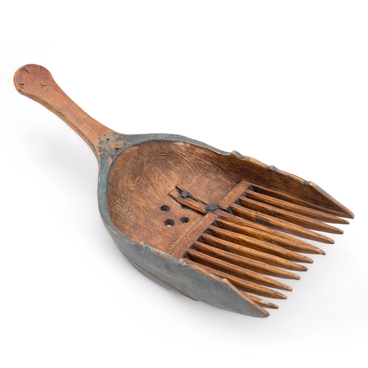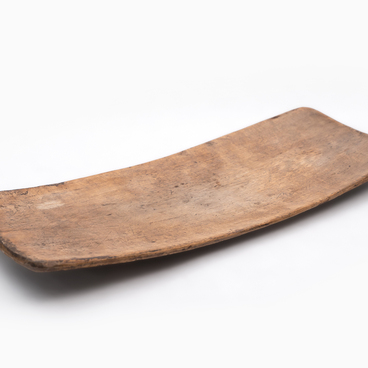A kitkem is a Sami cradle made of a solid piece of wood.
All groups of the Sami people used a cradle hollowed out of a tree trunk in the form of an oval-shaped trough or a boat with thin walls. The cradle was mostly made of pine or birch, which, according to the Sami people, had healing properties. A frame of two wooden arcs inserted into rectangular holes was attached above the headboard.
The cradle and the frame were covered with fine hand-tanned deerskin. Loose pieces of leather were attached to the sides and legs, which were used to cover the child. A canopy made of birch bark or cotton cloth was attached to the frame to protect the baby from mosquitoes. At the foot of the cradle there was a leather loop for hanging the cradle. Along the sides there were loops of twisted leather attached to the cradle. A woven woolen braid was threaded through these loops to secure the baby in the cradle. The child placed in the cradle was laced up.
Every Sami house had a kitkem. It was decorated with bugles, beads and colored cloth. Amulets were attached to it.
The book “The Baltic-Finniс Peoples of Russia” says that a newborn baby “was wrapped in warm hare fur and laid next to the mother. Three days later, when the umbilical cord fell off, the naked child was placed in a cradle made of a hollowed-out piece of wood. ˂…˃ During short distance movements, the mother carried the cradle with the child behind her back. During summer migrations, the cradle with the child was suspended from the saddle of a pack reindeer, and during winter migrations it was taken along in a keryozha [traditional Sami sledge].”
The cradle is decorated with rectangular-geometric patterns. Cradles were decorated with leather appliqué on leather, braid woven on the reed frame and beaded embroidery. Two types of braid were used: a wide braid, splitting into three narrow stripes, and a braid for lacing the cradle.
Since the Sami people often roamed after reindeer,
the mother put the kitkem around her neck on a special cord and held it so that
the child was in a semi-vertical position. Women breastfed their children for a
long time, sometimes up to three or four years. But at the same time, babies
were given a piece of cooked venison to suckle in the fourth month of life;
they were fed with chewed bread, lard and sugar, and berries were added to
their food.




